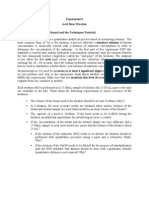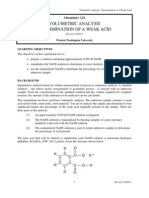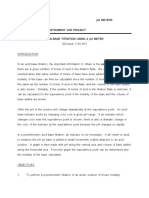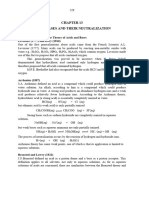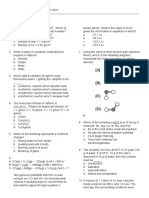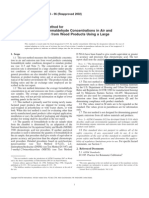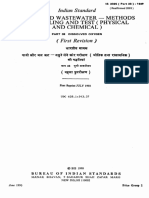0 ratings0% found this document useful (0 votes)
17 views111 Titration
111 Titration
Uploaded by
ElisaThis document provides instructions for conducting acid-base titration experiments. Students are asked to determine the molarity of strong and weak acid solutions by titrating them with a sodium hydroxide solution of a known concentration and recording the pH changes. Precise procedures are outlined for preparing the solutions, collecting pH data during the titration using a LabQuest interface, identifying the equivalence point on the resulting graph, and safely disposing of the solutions after neutralization. A trial with acetic acid is also to be completed.
Copyright:
© All Rights Reserved
Available Formats
Download as PPTX, PDF, TXT or read online from Scribd
111 Titration
111 Titration
Uploaded by
Elisa0 ratings0% found this document useful (0 votes)
17 views12 pagesThis document provides instructions for conducting acid-base titration experiments. Students are asked to determine the molarity of strong and weak acid solutions by titrating them with a sodium hydroxide solution of a known concentration and recording the pH changes. Precise procedures are outlined for preparing the solutions, collecting pH data during the titration using a LabQuest interface, identifying the equivalence point on the resulting graph, and safely disposing of the solutions after neutralization. A trial with acetic acid is also to be completed.
Original Title
111 Titration.pptx
Copyright
© © All Rights Reserved
Available Formats
PPTX, PDF, TXT or read online from Scribd
Share this document
Did you find this document useful?
Is this content inappropriate?
This document provides instructions for conducting acid-base titration experiments. Students are asked to determine the molarity of strong and weak acid solutions by titrating them with a sodium hydroxide solution of a known concentration and recording the pH changes. Precise procedures are outlined for preparing the solutions, collecting pH data during the titration using a LabQuest interface, identifying the equivalence point on the resulting graph, and safely disposing of the solutions after neutralization. A trial with acetic acid is also to be completed.
Copyright:
© All Rights Reserved
Available Formats
Download as PPTX, PDF, TXT or read online from Scribd
Download as pptx, pdf, or txt
0 ratings0% found this document useful (0 votes)
17 views12 pages111 Titration
111 Titration
Uploaded by
ElisaThis document provides instructions for conducting acid-base titration experiments. Students are asked to determine the molarity of strong and weak acid solutions by titrating them with a sodium hydroxide solution of a known concentration and recording the pH changes. Precise procedures are outlined for preparing the solutions, collecting pH data during the titration using a LabQuest interface, identifying the equivalence point on the resulting graph, and safely disposing of the solutions after neutralization. A trial with acetic acid is also to be completed.
Copyright:
© All Rights Reserved
Available Formats
Download as PPTX, PDF, TXT or read online from Scribd
Download as pptx, pdf, or txt
You are on page 1of 12
When you come in, please
Put all book bags, etc. away in cubbies
Hand in the Flow Chart for EXP 8 (Acid-Base Titration)
Hand in the Data Processing and Post Lab questions for 7
(Standardization of NaOH)
Acid-Base Titration
Experiment 8 Week of 4/6/15
Experimental Summary
Purpose
Conduct acid-base titrations
Compare equivalence points of strong and weak acids
Determine the Molarity of the two acid solutions
Molarity and Titrating Solutions
Molarity = moles of solute / liters of solution
Titration = the process used to determine the volume of a
solution needed to react with a given amount of another
substance
Can be used to determine the molarity of an unknown solution
Titrant = solution delivered from a buret
Equivalence point = the region where the smallest change in
volume causes the greatest change in pH
Preparing Solutions for Titration
Add 25 mL HCl to a 50 mL beaker
This will be your stock solution of HCL
Add 50 mL DI H2O to a 250 mL beaker
Use a 10 mL pipet to transfer 10 mL of the HCl to the 250 mL
beaker
Add a magnetic stir bar to the beaker and place it on a
magnetic stirrer
Set up the assembly as shown in figure 1
Fill the buret with 0.1 M NaOH
Setting Up Your LabQuest
From the File Sensors Screen, select Mode
This will bring up the mode menu
Melting Point
From the drop down menu under the mode function, select
Events With Entry
Enter volume for the name and mL for the unit
This will change the x axis to display as volume, instead of time
elapsed
Collecting data
Immerse the pH probe in the HCl
solution and begin your data
collection by pressing the play
button in the bottom left corner.
To create a new entry, select the
Keep button. This will save
your pH data and direct you to a
new screen where you must
enter the volume associated with
the entry.
The entry name should be the
exact volume of NaOH added (to
the nearest 0.05 mL).
When the trial is finished
Use the stock solution of HCL to neutralize the solution
pH between 6.5 and 7.5
Pour the solution down the drain
Rinse the pH sensor, the buret, your 250 mL beaker, and the
stir bar
Examine your data
Final Graph
After neutralizing and disposing of your solution, examine the
graph to find the volume at which the greatest change in pH
is achieved.
This is the equivalence point
Acetic Acid Trial
Repeat a trial using acetic acetic solution
Use data from a neighbor for trial 2 of the two acids
Special Considerations
Goggles and gloves are to be worn at all times
Make sure that the pH probes are immersed in the buffer
solution when they are put back.
NaOH is caustic. Handle with care.
HCL is a corrosive acid. Handle with care
Be sure to clean lab benches before leaving
WASH YOUR HANDS BEFORE LEAVING
You might also like
- IMPCA Ref Spec 01 July 2021Document16 pagesIMPCA Ref Spec 01 July 2021Magno GuzmanNo ratings yet
- Weak Acid Strong Base Titration LabDocument8 pagesWeak Acid Strong Base Titration Labapi-265089380100% (1)
- Manual of Formulas - Recipes, Methods & Secret ProcessesFrom EverandManual of Formulas - Recipes, Methods & Secret ProcessesRating: 4.5 out of 5 stars4.5/5 (2)
- Experiment 3 - Stoichiometry and Acid-Base Titrations RevisedDocument6 pagesExperiment 3 - Stoichiometry and Acid-Base Titrations Revisedomaraltiti20No ratings yet
- Acid - Base Titration Using PH Sensor-2Document4 pagesAcid - Base Titration Using PH Sensor-2tl60555No ratings yet
- 7B Acid-Base Titration - Unknown HCLDocument1 page7B Acid-Base Titration - Unknown HCLJacob DaughertyNo ratings yet
- Acid - Base Lab 2016 BegleyDocument7 pagesAcid - Base Lab 2016 BegleyIsaac SnitkoffNo ratings yet
- Soft DrinksDocument3 pagesSoft DrinkskiiieeeshieeeNo ratings yet
- The Effect of Added Acid and Base On The PH of Buffer Solutions PrelabDocument4 pagesThe Effect of Added Acid and Base On The PH of Buffer Solutions PrelabMirza Bilal MughalNo ratings yet
- Buffers Lab Write UpDocument7 pagesBuffers Lab Write Upapi-20078641850% (2)
- CWV 24 COMP Acid - Base - Titration PDFDocument8 pagesCWV 24 COMP Acid - Base - Titration PDFTha KantanaNo ratings yet
- Chemistry Practical ReportDocument12 pagesChemistry Practical ReportJonathan LukwichiNo ratings yet
- Acid Base TitrationDocument12 pagesAcid Base Titrationdonna benitoNo ratings yet
- Lab 27Document3 pagesLab 27api-239505062No ratings yet
- Lab 3: Introduction To Acids Base Chemistry Part A Experimental Determination of Acid Dissociation Constant, KaDocument10 pagesLab 3: Introduction To Acids Base Chemistry Part A Experimental Determination of Acid Dissociation Constant, Kaenock yegonNo ratings yet
- Step #3: Prepare The Primary Standard AcidDocument5 pagesStep #3: Prepare The Primary Standard AcidDavid NietoNo ratings yet
- 24 Acid-Base TitrationDocument5 pages24 Acid-Base Titrationgardarr11No ratings yet
- Titration. Lab - StudentDocument5 pagesTitration. Lab - Studentshoaib2769504No ratings yet
- Acid Base TitrationDocument6 pagesAcid Base TitrationSyameer YusofNo ratings yet
- Lab R.2 - Concentration of An Acid - Three WaysDocument6 pagesLab R.2 - Concentration of An Acid - Three WaysAdarsh Raj TiwariNo ratings yet
- Lab 2 - KHP - Volumetric AnalysisDocument5 pagesLab 2 - KHP - Volumetric AnalysisFiza MohdNo ratings yet
- Sulfamic Acid Titration C12!5!10Document5 pagesSulfamic Acid Titration C12!5!10Anonymous 1gXoNDYcNo ratings yet
- PH, Buffer, and Dissociation ConstantDocument5 pagesPH, Buffer, and Dissociation ConstantAlisher AbdugalimovNo ratings yet
- Lab Titration Hoac IntroDocument3 pagesLab Titration Hoac IntroIsaac Nicholas NotorioNo ratings yet
- Titration LabDocument2 pagesTitration LabAliayah RoweNo ratings yet
- Experiment 7: Titration of An Antacid: Objective: in This Experiment, You Will Standardize A Solution of Base Using TheDocument7 pagesExperiment 7: Titration of An Antacid: Objective: in This Experiment, You Will Standardize A Solution of Base Using TheDALITSO CHIKOYANo ratings yet
- Chem 12 Expt12Document4 pagesChem 12 Expt12Kim Shyen BontuyanNo ratings yet
- AP Chemistry - Titration Curves of Strong and Weak Acids and BasesDocument5 pagesAP Chemistry - Titration Curves of Strong and Weak Acids and BasesJonathan Chen100% (2)
- PH Meters Purdue University Instrument Van Project Acid-Base Titration Using A PH MeterDocument5 pagesPH Meters Purdue University Instrument Van Project Acid-Base Titration Using A PH MeterNatsu PatnaikNo ratings yet
- Procedure - Top HatDocument8 pagesProcedure - Top Hatayushsocial2002No ratings yet
- Tit RationDocument7 pagesTit RationgautamahujaNo ratings yet
- CHEM I 17 Acid Base Titrations OpenDocument4 pagesCHEM I 17 Acid Base Titrations OpenAchinthya PereraNo ratings yet
- Titration of Citric Acid CHEM 103 LabDocument4 pagesTitration of Citric Acid CHEM 103 LabTANMAY ANANDNo ratings yet
- Experiment 4: Titration With Oxalic Acid: (Known) (Unknown)Document4 pagesExperiment 4: Titration With Oxalic Acid: (Known) (Unknown)Aditya SinghNo ratings yet
- Acid-Base Titration by Dan HolmquistDocument5 pagesAcid-Base Titration by Dan HolmquistPaul SchumannNo ratings yet
- Lab Experiment - Titration of Sulfuric Acid (H2SO4)Document2 pagesLab Experiment - Titration of Sulfuric Acid (H2SO4)gdfeiu dionwdnNo ratings yet
- Titration Part 1Document5 pagesTitration Part 1takomolyentinNo ratings yet
- Ch60 (2015) Expt 17 Acid-Base TitrationsDocument6 pagesCh60 (2015) Expt 17 Acid-Base TitrationsnataliariesgocortesNo ratings yet
- KHP LabDocument5 pagesKHP LabSantino MusaNo ratings yet
- Determination of Aspirin Using Back TitrationDocument10 pagesDetermination of Aspirin Using Back TitrationAldi Igniel100% (1)
- Potentiometric Titration CurvesDocument5 pagesPotentiometric Titration CurvesDavid GrahamNo ratings yet
- Titration Notes: MethodDocument3 pagesTitration Notes: MethodArSlanRahatNo ratings yet
- 6 - Acid Base Titration Weak AcidsDocument5 pages6 - Acid Base Titration Weak AcidsDanNo ratings yet
- Chapter 4 Lab Titration of Hydrochloric Acid With Sodium Hydroxide PDFDocument4 pagesChapter 4 Lab Titration of Hydrochloric Acid With Sodium Hydroxide PDFMara ScisciNo ratings yet
- Preparation of A Naoh Standard Solution Using Direct TitrationDocument4 pagesPreparation of A Naoh Standard Solution Using Direct TitrationMuhammad jawadNo ratings yet
- Experiment 1 Standardization of Acid and Base SolutionDocument6 pagesExperiment 1 Standardization of Acid and Base SolutionMarco AdenNo ratings yet
- Chem 11 Expt8Document6 pagesChem 11 Expt8samueljozaiti3No ratings yet
- Lab 11 Acids, Bases, PH, Hydrolysis, and BuffersDocument10 pagesLab 11 Acids, Bases, PH, Hydrolysis, and BuffersChing Wai Yong67% (3)
- Experiment 3Document3 pagesExperiment 3Siti Rahmah YahyaNo ratings yet
- Sinha TitrationcurvesDocument11 pagesSinha TitrationcurvesRadu StafiNo ratings yet
- Acid and Base Titration Lab ReportDocument5 pagesAcid and Base Titration Lab ReportAcademic CoordinatorNo ratings yet
- K00326 - 20181121132815 - Lab Manual SKU1023Document26 pagesK00326 - 20181121132815 - Lab Manual SKU1023Kamilia AfiqahNo ratings yet
- SP12 1011 Titration of Hydrochloric Acid With Sodium Hydroxide 0Document7 pagesSP12 1011 Titration of Hydrochloric Acid With Sodium Hydroxide 0nirajsahu770032No ratings yet
- Acid/Base Chemistry: Titration Lab: What Is A Titration?Document7 pagesAcid/Base Chemistry: Titration Lab: What Is A Titration?Barça LaNo ratings yet
- 121Document8 pages121madimcd20No ratings yet
- Standardization of Acid and Base SolutionsDocument4 pagesStandardization of Acid and Base SolutionsMAISHA TASNEEMNo ratings yet
- TitrationjDocument6 pagesTitrationjslixsterNo ratings yet
- Advanced Pharmaceutical analysisFrom EverandAdvanced Pharmaceutical analysisRating: 4.5 out of 5 stars4.5/5 (2)
- Plant and Animal Bio-Chemistry - Including Information on Amino Acids, Proteins, Pigments and Other Chemical Constituents of Organic MatterFrom EverandPlant and Animal Bio-Chemistry - Including Information on Amino Acids, Proteins, Pigments and Other Chemical Constituents of Organic MatterNo ratings yet
- Practical Manual of Analytical ChemistryFrom EverandPractical Manual of Analytical ChemistryRating: 4.5 out of 5 stars4.5/5 (3)
- Chemistry at Home - A Collection of Experiments and Formulas for the Chemistry EnthusiastFrom EverandChemistry at Home - A Collection of Experiments and Formulas for the Chemistry EnthusiastNo ratings yet
- MECHS Titration Lab.Document3 pagesMECHS Titration Lab.ElisaNo ratings yet
- Lab 7: Column Chromatography CHE 203 - Summer 2017Document8 pagesLab 7: Column Chromatography CHE 203 - Summer 2017ElisaNo ratings yet
- 111 AlumDocument15 pages111 AlumElisaNo ratings yet
- Chromatography Fall 2016Document19 pagesChromatography Fall 2016ElisaNo ratings yet
- L1 - 111 - PPT EFBDocument9 pagesL1 - 111 - PPT EFBElisaNo ratings yet
- Det. Chem. FormulaDocument15 pagesDet. Chem. FormulaElisaNo ratings yet
- Topic 12 Answers To ExercisesDocument2 pagesTopic 12 Answers To ExercisesRoshae SinclairNo ratings yet
- Sample Test - ComplexometryDocument2 pagesSample Test - Complexometrymstruclinh03No ratings yet
- Mud Lab TestsDocument1 pageMud Lab Testssamiwarraich519No ratings yet
- Chemistry 3B ExaminationDocument4 pagesChemistry 3B Examinationkulwayohana61No ratings yet
- Quice Review Center: C) The Total Mass of The Atom A) RBDocument5 pagesQuice Review Center: C) The Total Mass of The Atom A) RBMary Francia RicoNo ratings yet
- Conductometric TitrationDocument2 pagesConductometric TitrationAnkit RoyNo ratings yet
- Pag 12.1 Write UpDocument6 pagesPag 12.1 Write UpAdiNo ratings yet
- M.SC Chemistry Sem 1 To 4 (2020-2022) (Analytical, Inorganic, Organic, Physical)Document119 pagesM.SC Chemistry Sem 1 To 4 (2020-2022) (Analytical, Inorganic, Organic, Physical)yur fanNo ratings yet
- Chap 13Document19 pagesChap 13Tun Lin AungNo ratings yet
- USGS Method I 2030 (Alkalinity)Document2 pagesUSGS Method I 2030 (Alkalinity)link815No ratings yet
- Bpharm Cbcssyllabus 11220181012.155248 PDFDocument155 pagesBpharm Cbcssyllabus 11220181012.155248 PDFTanu NaikNo ratings yet
- Titration Post LabDocument3 pagesTitration Post LabGianella SamonteNo ratings yet
- STD Na2S2O3Document2 pagesSTD Na2S2O3AbuSayedNo ratings yet
- Module 9 - Acid - Base ChemistryDocument15 pagesModule 9 - Acid - Base ChemistryAna Maria Millan RinconNo ratings yet
- ChemistryDocument6 pagesChemistryRona Mae GuevarraNo ratings yet
- SNI 0494-2008 Pulp - Cara Uji Bilangan KappaDocument4 pagesSNI 0494-2008 Pulp - Cara Uji Bilangan KappaMar'atul FauziyahNo ratings yet
- Question Answer of ComplexometryDocument19 pagesQuestion Answer of ComplexometryNahzim RahmatNo ratings yet
- Astm d1333Document12 pagesAstm d1333No NamidaNo ratings yet
- (PDF) Assessment of Sachet Water Quality in Kumasi, GhanaDocument18 pages(PDF) Assessment of Sachet Water Quality in Kumasi, GhanaJephthah YachamNo ratings yet
- AOCS Official Method Ca 14Document7 pagesAOCS Official Method Ca 14Gerson JuniorNo ratings yet
- Industrial Crops & Products: A A B C D e F GDocument13 pagesIndustrial Crops & Products: A A B C D e F GDerek ZoolanderNo ratings yet
- CSEC Chemistry June 2016 P032Document10 pagesCSEC Chemistry June 2016 P032nam tiddiesNo ratings yet
- Aspirin - British PharmacopoeiaDocument5 pagesAspirin - British PharmacopoeiasacashtureNo ratings yet
- Electroanalytical Methods and Potentiometry PDFDocument15 pagesElectroanalytical Methods and Potentiometry PDFLilato ChanganiNo ratings yet
- Water and Wastewater - Methods of Sampling and Test (Physical and Chemical)Document7 pagesWater and Wastewater - Methods of Sampling and Test (Physical and Chemical)lucky259No ratings yet
- Multiple Choice Question Bank - 2 Subject: - Engineering ChemistryDocument18 pagesMultiple Choice Question Bank - 2 Subject: - Engineering ChemistryJitendra BaravkarNo ratings yet
- Ab-233 4 enDocument9 pagesAb-233 4 enRuth CastroNo ratings yet
- Lab 2 Biochemistry (Quantitative Food Test) 2Document5 pagesLab 2 Biochemistry (Quantitative Food Test) 2Michael TimsonNo ratings yet
- Titration QuestionsDocument4 pagesTitration QuestionsZeeshan AhmadNo ratings yet


















